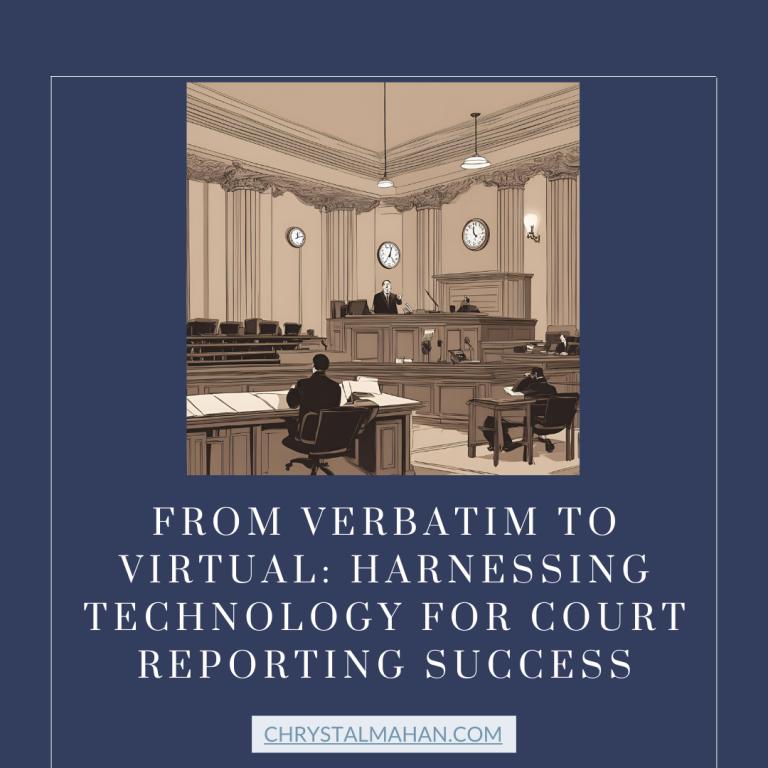Why a Digital Court Reporter Could Be Better Than a Stenographer in 2024


Revolutionizing Court Reporting: The Digital Edge
The courtroom is no exception in an era where technology permeates every aspect of our lives. The legal system, traditionally slow to embrace technological advancements, is now witnessing a seismic shift with the rise of digital court reporting. Imagine a courtroom where the proceedings are captured with impeccable accuracy, immediate accessibility, and seamless integration into digital workflows. This is not a distant future; this is 2024, and digital court reporting is transforming the landscape of legal documentation.
I remember sitting in a courtroom a few years ago, watching a stenographer furiously type away, capturing every word spoken with remarkable speed. The clattering of the stenotype machine was almost hypnotic, a sound synonymous with the diligent recording of legal proceedings. However, that scene now feels like a relic of the past. Today, digital court reporters equipped with sophisticated technology are becoming the norm, providing numerous advantages over traditional stenographers.
As the legal profession grapples with the demands of a fast-paced digital world, the benefits of digital court reporting become increasingly evident. From enhanced accuracy and efficiency to cost savings and future-proofing the judicial process, digital court reporters are proving to be indispensable in modern legal settings. Let’s delve into the compelling reasons why digital court reporters are outpacing their stenographic counterparts in 2024.
Superior Accuracy and Reliability
One of the most compelling reasons for the shift towards digital court reporting is its superior accuracy and reliability. Despite their skill, traditional stenographers are still human and prone to errors. Misheard words, typographical mistakes, and fatigue can all lead to inaccuracies in the court record. In contrast, digital court reporters utilize advanced recording devices and speech recognition software that captures every word with high fidelity. This technology significantly reduces the margin of error, ensuring that the legal record is precise and trustworthy.
Digital court reporting provides a robust backup system. Digital recordings can be stored in multiple locations, both on-site and in the cloud, safeguarding against data loss. This redundancy is crucial in legal contexts where the integrity and availability of records are paramount. Should any discrepancies arise, the original audio can be reviewed to verify the transcript’s accuracy, providing an additional layer of reliability that traditional methods lack.
Additionally, digital court reporters can incorporate timestamps and annotations into their recordings, allowing quick navigation through hours of testimony. This feature is incredibly beneficial during appeals or reviews, where specific portions of the transcript must be examined in detail. Such precision and accessibility are unmatched by traditional stenographic records.
Enhanced Efficiency and Productivity
Efficiency is another area where digital court reporters outperform stenographers. Digital technology significantly streamlines the process of creating, reviewing, and distributing court transcripts. Thanks to advanced transcription software that remarkably quickly converts spoken words into text, digital court reporters can produce transcripts almost in real time. This immediate availability of transcripts facilitates quicker case resolutions and enhances the overall efficiency of the judicial process.
Using digital tools allows for seamless integration with other legal technologies. For instance, digital transcripts can be easily searched, annotated, and linked to case management systems. This interoperability saves time and reduces the administrative burden on court staff and legal professionals. Lawyers can quickly locate and reference specific portions of the transcript, improving their ability to prepare for cases and respond to developments.
Another aspect of productivity is the reduction in turnaround time for transcript delivery. Traditional stenographers often require significant time to transcribe and proofread their notes, which can delay the availability of the final record. In contrast, digital court reporters can offer expedited services, sometimes providing same-day delivery of transcripts. This rapid turnaround is particularly beneficial in high-stakes cases where timely access to accurate records is critical.
Cost Savings and Accessibility
The cost benefits of digital court reporting are substantial. Training and maintaining a team of skilled stenographers can be expensive. The specialized equipment they use and ongoing professional development add to these costs. Digital court reporting, however, leverages widely available technology that can be more easily scaled and maintained. Lower operational costs over time offset the initial investment in high-quality recording devices and software.
Digital court reporting democratizes access to court records. The ease of sharing and distributing digital transcripts means that all parties involved in a case can access the information they need without significant delay or additional expense. This is particularly advantageous for smaller legal practices and self-represented litigants who may not have the resources to afford traditional transcription services.
Digital court reporting can help address the shortage of qualified court reporters. With fewer people entering the stenography profession, courts face challenges meeting the demand for skilled reporters. Digital solutions can fill this gap, ensuring the legal system continues functioning smoothly without the constraints imposed by a limited pool of stenographers.
Future-Proofing the Legal Process
As we look to the future, it is clear that digital court reporting is not just a temporary trend but a fundamental shift in how legal records are created and maintained. The adaptability and scalability of digital solutions make them well-suited to evolving technological landscapes. Emerging technologies such as artificial intelligence and machine learning promise to enhance the capabilities of digital court reporters further, offering even greater accuracy and efficiency.
For instance, AI-powered transcription services are continually improving and learning to recognize and interpret legal terminology and complex speech patterns better. This ongoing advancement ensures that digital court reporting will remain at the cutting edge of legal documentation, providing superior service compared to traditional methods.
Additionally, the move toward digital court reporting aligns with broader societal trends toward digitalization and sustainability. Reducing reliance on paper records and physical storage cuts costs and supports environmental goals. Courts adopting digital practices can position themselves as forward-thinking institutions ready to meet the demands of a rapidly changing world.
Technology Always Has Been and Always Will Be – The Future
The transition from stenographic to digital court reporting represents a significant advancement in the legal field. With superior accuracy, enhanced efficiency, substantial cost savings, and future-proof capabilities, digital court reporters are well-equipped to meet the demands of modern legal practice. As technology continues to evolve, the advantages of digital court reporting will only become more pronounced, ensuring that the judicial system remains effective, accessible, and ready for future challenges. The courtroom of 2024, powered by digital innovation, promises a new era of precision and productivity in legal documentation.






